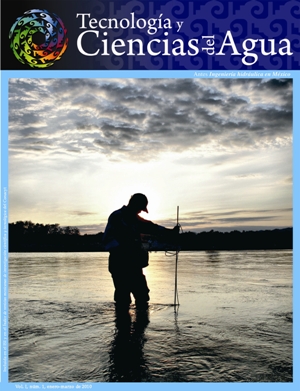Pérdidas por intercepción en mezquite (Prosopis Laevigata) y huizache (Acacia farnesiana) de la región semiárida del centro de México
DOI:
https://doi.org/10.24850/j-tyca-2010-01-08Palabras clave:
pérdidas por intercepción, evaporación, percolación, flujo cortical, balance hídrico, ecosistemas semiáridos, modelaciónResumen
El estudio fue realizado en el periodo de lluvias de 2006 en tres sitios del semiárido centro de México: “El Carmen”, en el estado de Guanajuato; “Amazcala” y “Cadereyta”, en el estado de Querétaro; ello, con el objetivo de estudiar el comportamiento de las pérdidas por intercepción, EI, de dos especies dominantes, mezquite (Prosopis laevigata) y huizache (Acacia farnesiana). El experimento se basó en la metodología de Guevara-Escobar et al. (2007). La modelación de las EI por tormenta fue construida con dos modelos de base física, Rutter, Gash, y un tercero del tipo lineal múltiple (RLM). En cada sitio fueron seleccionados dos árboles de ambas especies. La precipitación en 2006 fue de 770 mm en El Carmen y de 732 mm en Cadereyta. En Amazcala, en el periodo agosto-noviembre, de 451 mm. En proporción a la precipitación, las EI por evento resultaron de 15, 20 y 27% en huizache, y de 27, 22 y 17% en mezquite, para Cadereyta, El Carmen y Amazcala, respectivamente. Estadísticamente, las eficiencias de modelos de Gash, Rutter y RLM correspondientes a los tres sitios resultaron de -0.1<E<0.34, -4.41<E<0.8 y -1.19<E<0.94. Las diferencias en porcentaje entre las observaciones y los modelos para el periodo de estudio fueron de <120%, siendo el modelo RLM el más eficiente(0%). La prueba ANOVA entre árboles y sitios no mostró diferencias estadísticamente significativas, por lo cual fue generada una correlación para estimar las EI en el contexto regional, de donde se obtuvo un promedio del 20% de intercepción.Citas
ALLEN, R.G., PEREIRA, L.S., RAES, D. and SMITH, M. Crop evapotranspiration-Guidelines for computing crop water requirements. Rome: FAO, 1998, 298 pp.
BECERRIL-PIÑA, R., GONZÁLEZ-SOSA, E. and HERNÁNDEZ-SANDOBAL, L. El semiárido mexicano como sumidero de carbono. Estudio de caso Microcuenca “El Carmen”. Memorias del Congreso Nacional y Reunión Mesoamericana de Manejo de Cuencas Hidrográficas. México, D.F. Instituto Nacional de Ecología, 2007, 8 pp.
CARLYLE-MOSES, D.E. Throughfall, stemflow, and canopy interception loss fluxes in a semi-arid Sierra Madre Oriental matorral community. Journal of Arid Environments. Vol. 58, 2004, pp. 180-201.
CROCKFORD, R.H. and RICHARDSON, D.P. Partitioning of rainfall into through fall, stem flow and interception: efect of forest type, ground cover and climate. Hydrol. Process. Vol. 14, 2000, pp. 2903-2920.
GASH, J.H.C. An analytical model of rainfall interception in forests. Quarterly Journal of the Royal Meteorological Society. Vol. 105, 1979, pp. 43-55.
GROEN, M.M. and SAVENIJE, H.H. A monthly interception equation based on the statistical characteristics of daily rainfall. Water Resources. Vol. 42, 2006, pp. 1-10.
GUEVARA-ESCOBAR, A., GONZÁLEZ-SOSA, E., VÉLIZ-CHAVEZ, C., VENTURA-RAMOS, E. and RAMOS-SALINAS, M. Rainfall interception and distribution patterns of gross precipitation around an isolated Ficus benjamina tree in an urban area. Journal of Hydrology. Vol. 333, 2007, pp. 532-541.
HORTON, R.E. Rainfall interception. Monthly Weather Review. Vol. 47, 1919, pp. 603-623.
LEYTON, L., REYNOLDS, R.C. and THOMPSON, F.B. Rainfall interception in forest and moorland. Forest Hydrology. Vol. 163, 1967, 179 pp.
LIU, S. A new model for the prediction of rainfall interception in forest canopies. Ecological Modelling. Vol. 99, 1997, pp. 151-159.
LOESCHER, H.W., POWERS, J.S. and OBERBAUER, S.F. Spatial variation of through fall volume in an old-growth tropical wet forest. Journal of Tropical Ecology. Vol. 18, 2002, pp. 397-407.
MONTEITH, J.L. Evaporation and the environment. Symposium of the Society of Experimental Biology. Vol. 19, 1965, pp. 245-269.
NAVAR, J. and BRYAN, R.B. Fitting the analytical model of rainfall interception of Gash to individual shrubs of semi-arid vegetation in northeastern México. Agricultural and Forest Meteorology. Vol. 68, 1994, pp. 133-143.
NAVAR, J., CARLYLE-MOSES, D.E. and MARTÍNEZ, M.A. Interception loss from the Tamaulipan matorral thorn scrub of north-eastern Mexico: an application of the Gash analytical interception loss model. Journal of Arid Environment. Vol. 41, 1999, pp. 1-10.
RAAT, K.J., DRAAIJERS, G.P.J., SCHAAP, M.G., TIETEMA, A. and VERSTRATEN, J.M. Spatial variability of through all water and chemistry and forest floor water content in a Douglas fir forest stand. Hydrology and Earth System Sciences. Vol. 6, 2002, pp. 363-74.
RODRIGO, A. and ÁVILA, A. Influence of simple size in the estimation of mean through fall in two Mediterranean holm oak forests. Journal of Hydrology. Vol. 243, 2001, pp. 216-227.
RUTTER, A.J., KERSHAW, K.A., ROBINS, P.C. and MORTON, A.J. A predictive model of rainfall interception in forests: derivation of the model from observations in a plantation of Corsican pine. Agricultural Meteorology. Vol. 9, 1971, pp. 367-384.
RUTTER, A.J., MORTON, A.J. Y ROBINS, P.C. A predictive model of interception loss in forest. II. Generalization of the model and comparison with observations in some coniferous and hardwood stands. Journal of Applied Ecology. Vol. 12, 1975, pp. 367-380.
SCHELLEKENS, J., SCATENA, F., BRUIJNZEEL, L. and WICKEL, A. Modeling rainfall interception in lowland rain in forest in Northeastern Puerto Rico. Hydrology. Vol. 225, 1999, pp. 168-184.
VAN-DIJIK, A.I.J.M. and BRUIJNZEEL, L.A. Modeling rainfall interception by vegetation of variable density using an adapted analytical model. Part 1. Model description. Journal of Hidrology. Vol. 247, 2001, pp. 230-238.
XIAO, Q.F., MCPHERSON, E.G., USTIN, S.L. and GRISMER, M.E. A new approach to modeling tree rainfall interception. Journal of Geophysical Research-Atmospheres. Vol. 105, 2000, pp. 29173-29118.
ZENG, N., SHUTTLEWORTH, J.W. and GASH, J.H.C. Influence of temporal variability of rainfall on interception loss. Part I. Point analysis. Journal of Hydrology. Vol. 228, 2000, pp. 228-241.
Descargas
Publicado
Cómo citar
Número
Sección
Licencia
Derechos de autor 2010 Tecnología y ciencias del agua

Esta obra está bajo una licencia internacional Creative Commons Atribución-NoComercial-CompartirIgual 4.0.
Por Instituto Mexicano de Tecnología del Agua se distribuye bajo una Licencia Creative Commons Atribución-NoComercial-CompartirIgual 4.0 Internacional. Basada en una obra en https://www.revistatyca.org.mx/. Permisos que vayan más allá de lo cubierto por esta licencia pueden encontrarse en Política editorial









